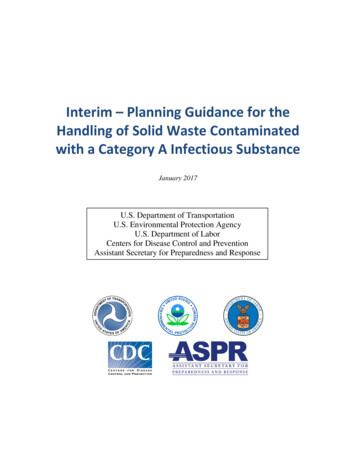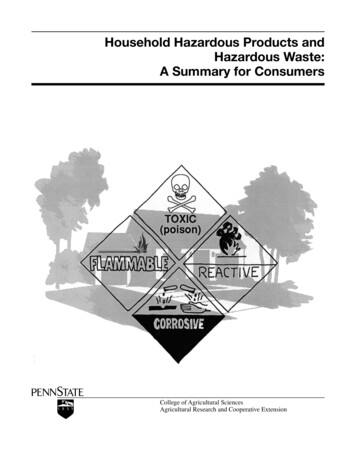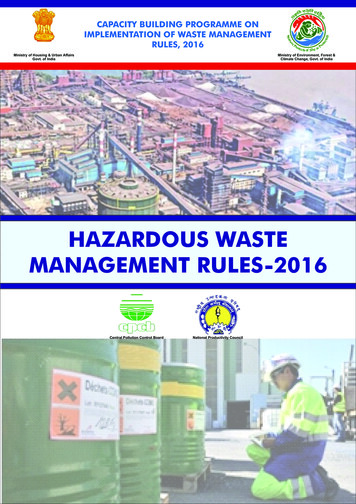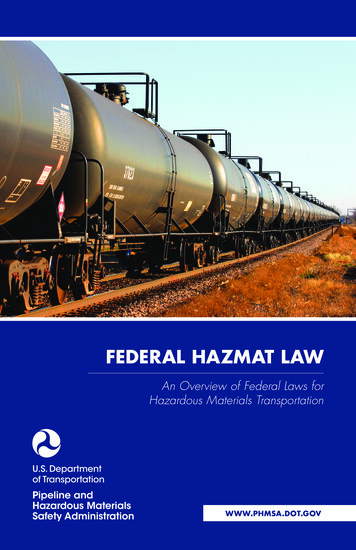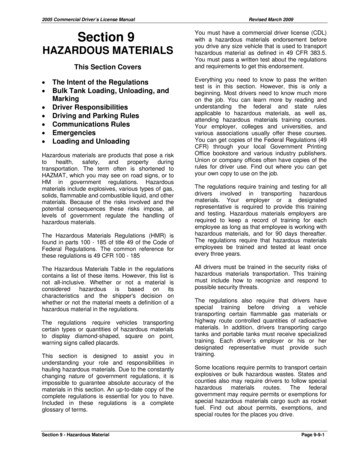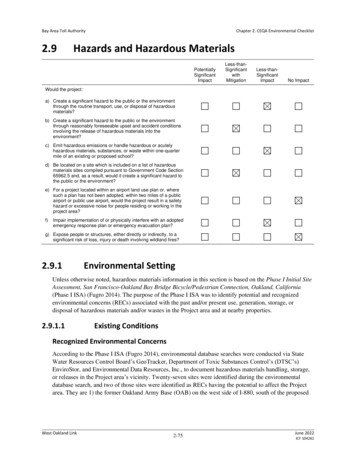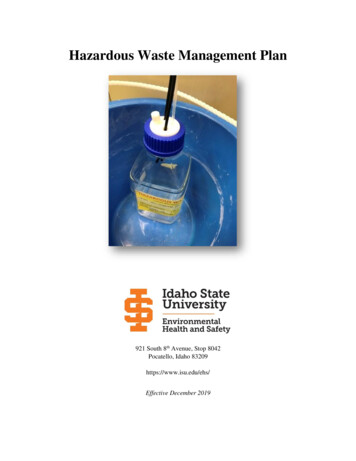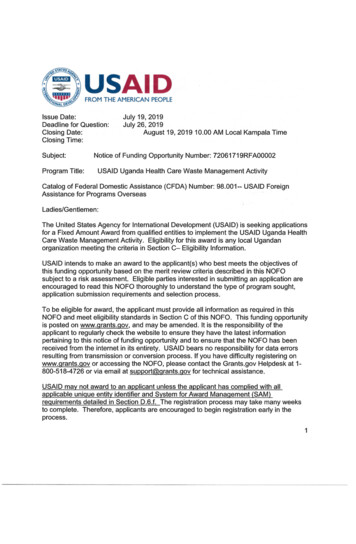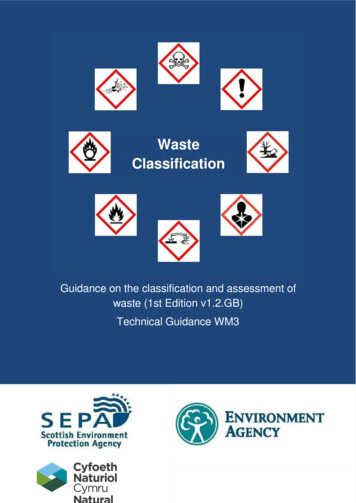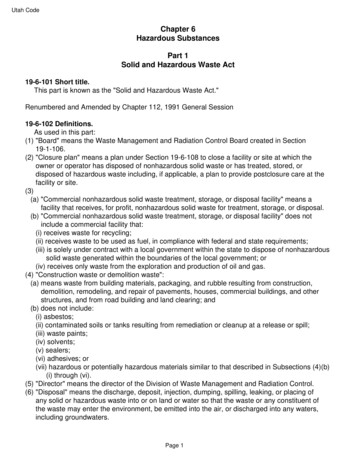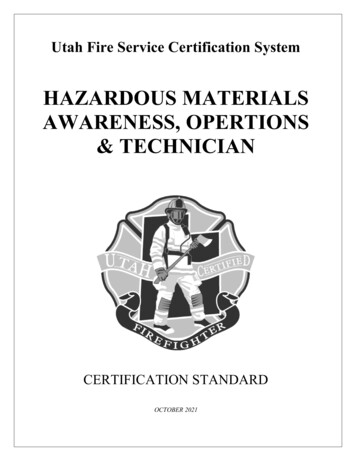
Transcription
Utah Fire Service Certification SystemHAZARDOUS MATERIALSAWARENESS, OPERTIONS& TECHNICIANCERTIFICATION STANDARDOCTOBER 2021
ii
Utah Fire Service Certification CouncilChairpersonScott Spencer, ChiefPayson Fire DepartmentVice-ChairpersonJason Earl, Deputy ChiefOrem Fire DepartmentCouncil MembersTJ Brewer, ChiefMoab Fire DepartmentRod Hammer, ChiefCache County Fire DistrictRon Harris, ChiefTropic Fire DepartmentKrista Horting, Battalion ChiefWeber Fire DistrictJeremy Raymond, Chief/DirectorUintah Fire Suppression SSDWade Snyder, Asst Fire Mgmt. OfficerDivision of Forestry, Fire & State LandsMerlin Spendlove, Battalion ChiefHurricane Fire & RescueRod “Hoss” Tomkinson, CaptainLogan Fire DepartmentChristopher Trevino, Battalion ChiefWest Jordan Fire DepartmentDavid Youngberg, Battalion ChiefNorth Davis Fire DistrictUtah Fire & Rescue Academy StaffDirectorBrad WardleProgram ManagerLori HowesCertification SpecialistsJennifer Lindley – Northern RegionTrudy Meister – Central RegionSharon Stokes – Salt Lake County/Southern RegionFor questions or comments concerning this or other Utah certification standards contact:Utah Fire Service Certification CouncilUtah Fire & Rescue AcademyUtah Valley University3131 Mike Jense ParkwayProvo, Utah 84601Toll-Free # 1-888-548-7816FAX # 801-374-0681www.uvu.edu/ufraiii
Hazardous Materials Awareness and Hazardous Materials OperationsTechnical CommitteeThe Certification Council would like to recognize and extend a voice of appreciation to thefollowing fire service professionals for their work on the Hazardous Materials Awareness,Operations, and Technician standards. These individuals devoted many hours to reviewing theNational Fire Protection Association (NFPA) 1072 standard, certification test banks, and reviewingand developing the skills for this standard.Thank You Hazardous Materials Awareness & OpsHazardous Materials TechnicianDave Youngberg, Battalion ChiefNorth Davis Fire District*Certification Council RepresentativeHoss Tomkinson, CaptainLogan Fire Department*Certification Council RepresentativeAdam Davies, CaptainSalt Lake City Fire Department*HazMat Advisory Council RepresentativeRyan Peterson, Battalion ChiefOrem Fire DepartmentHoss Tomkinson, Paramedic CaptainLogan Fire DepartmentPaul Bedont, ChiefPrice Fire DepartmentAdam Davies, CaptainSalt Lake City Fire DepartmentGolden Barrett, Battalion ChiefHill Air Force Base Fire DepartmentAnthony Stowe, CaptainSalt Lake City Fire DepartmentWade Francis, Deputy State Fire Marshall HazMatState Fire Marshal’s OfficeMatt Evans, ChiefWashington City Fire DepartmentTony Stowe, HazMat SpecialistSalt Lake City Fire DepartmentRandy Willden, ChiefNorth Toole Fire DistrictJeremy Winn, Captain/HazMat TrainingOfficerWeber Fire DistrictKarl Steadman, Battalion ChiefSalt Lake City Fire DepartmentJordan Smith, HazMat Technician CaptainCedar City Fire DepartmentCody Barton, HazMat TechnicianSevier County Emergency Managementiv
TABLE OF CONTENTSIntroduction . 1Hazardous Materials Awareness Certification Requirements .4Entrance Requirements .4Department Training Officers .5Department TrainingWritten Objectives.5Skills Objectives.6Department Training Records .6"In House" Skills Examination .7Certification ExaminationsWritten .7Skills "Spot Check" .8HazMat Awareness CertificationCertification .9Re-certification.9HazMat Awareness Checklist . 10HazMat Awareness Skill ObjectivesRecognition and Identification .11Initiate Protective Action .11Notification .11Training RecordHazardous Materials Awareness Training Record .12Hazardous Materials Operations Certification Requirements .13Entrance Requirements .13Department Training Officers .13Department TrainingWritten Objectives.14Skills Objectives.15Department Training Records .15"In House" Skills Examination .15Certification ExaminationsWritten .16Skills "Spot Check" .16HazMat Operations CertificationPrerequisites for Certification .18Re-certification.18Hazardous Materials Operations Checklist . 19
Hazmat First Responder Operations Skill ObjectivesReporting and Documentation .20Decontamination .22Personal Protective Equipment .24Performing Defensive Control Actions .26Training RecordHazardous Materials Operations Training Record .28Hazardous Materials Technician Certification Requirements .31Entrance Requirements .31Physical Fitness Requirements.31Department Training Officers .32Department TrainingWritten Objectives.33Skills Objectives.33Department Training Records .34Department “In-house” Skill Exam .34Certification ExaminationsWritten .34Skills “Spot Check” .35Hazardous Material Technician CertificationPrerequisites for Certification .36Re-certification.36Hazardous Materials Technician Certification Checklist . 37Hazardous Materials Technician Skill ObjectivesSurveying the Hazardous Materials Incident .38Implementing the Planned Response.42Using Protective Clothing.46Performing Control Functions.48Reports and Documentation.54Training RecordHazardous Materials Technician Training Record .58Appendix A – Decontamination CorridorExample of Multiple Station Decontamination Corridor.62Appendix B - In-House Proctor InstructionsProctor Instructions for “In-House” Comprehensive Examination .64Appendix C - Certification FormsIntent to Participate .66Examination Request Form.67Certification/Recertification Request Form .70vi
INTRODUCTIONThe world we live in is rapidly changing, and the many phases of the Fire Service are becoming so technicaland complex that fire service training must be utilized to its maximum potential. Any overlap, fragmentation,and lack of basic structure must be eliminated. Standardization is the natural complement and necessity.The fire service in Utah, through a state certification program, can meet the needs of future growth andestablish uniformity through certification. We will then have more effective and efficient utilization ofresources so as to provide the best possible fire protection service for all the citizens throughout the state ofUtah.The following certification requirements are based on the objectives listed in the National Fire ProtectionAssociation (NFPA) 1001 standard for Fire Fighter Professional Qualifications, 2019 Edition, as verifiedand adopted by the Utah Fire Service Certification Council (UFSCC).Through these national standards and certification, candidates and fire departments have a tool to measurespecific levels of skills, abilities and knowledge. The UFSCC believes that by participating in thesecertification program candidates and fire departments will be better prepared to provide quality life safetyand fire protection for their communities.The following Utah Hazardous Materials state standard covers three levels of certification:Hazardous Materials AwarenessThe focus and purpose of Hazardous Materials Awareness is to give the front line firefighter the ability to:-Detect and identify the presence of a hazardous material.Collect information from the Emergency Response Guidebook.Take protective actions by isolating the area and denying entry.Make proper notifications to local/state/national organizations.Hazardous Materials OperationsThe focus and purpose of Hazardous Materials Operations is to give the front line firefighter the ability to:-Perform all competencies as developed at the Awareness level.Collect information using MSDS, CHEMTREC, local LEPCPerform LIMITED defensive actions.Establish and manage a decontamination corridor (under direction from a qualified HM Technician).Don splash type protective clothing to assist as needed at a hazardous materials incident.With successful completion of this standard which is based on the NFPA 1072, 2017 edition, a candidate willhave satisfied all requirements for the Hazardous Materials Awareness and Operation levels as listed in theOSHA 29 CFR 1910.120(q)(6)(i) Awareness and OSHA 29 CFR 1910.120(q)(6)(ii) Operations.1
Hazardous Materials TechnicianThe focus and purpose of the Technician Level Responder is to give the front line firefighter the ability to:-Demonstrate all competencies as developed at the Technician level.Collect and interpret hazard and response information.Determine extent of damage to containers.Identify the response objectives for a hazardous materials incident.Select PPE for a given action and decontamination procedures.Don, work-in, doff Level A and B suits.Perform control functions as determined by the action plan.Evaluate, debrief, critique and document an incident.With successful completion of this standard which is based on the NFPA 1072, 2017 edition, a candidate willhave satisfied all requirements for the Hazardous Materials Technician as listed in the OSHA 29 CFR1910.120(q)(6)(iii).In Memoriam, September 11, 2001We pay tribute to the 343 members of FDNY who gave their lives to save civilian victims on September 11,2001, at the World Trade Center. They are true American heroes in death, but they were also Americanheroes in life. We will keep them in our memory and in our hearts. They are the embodiment of courage,bravery, and dedication. May they rest in peace.2
HAZARDOUSMATERIALSAWARENESSCERTIFICATIONSTANDARD3
HAZARDOUS MATERIALS AWARENESSCERTIFICATION REQUIREMENTSIn order to certify within the Utah Hazardous Materials Awareness program, candidates must fulfill thefollowing requirements:1.2.3.4.5.6.7.8.Complete entrance requirements.Set-up and maintain department records.Train on the required written and skills objectives.Pass a department “In-House” practical skills examination.Meet any other training requirements/prerequisites as defined by the Certification Council.Pass both written and practical skills examination administered by the Certification Council.Request Hazardous Materials Awareness Certification.Request re-certificationEntrance RequirementsThe UFSCC acknowledges the importance of and need for entrance requirements as listed in the NFPA 1001standard on Fire Fighter Professional Qualifications. Many agencies and departments have existing policies,regulations, etc., already in place regarding these requirements. The handling of entrance requirements is aLOCAL MATTER, outside the authority and jurisdiction of the UFSCC. The Council will not check, test,evaluate or determine how individual agencies meet these requirements. Some departments have found itnecessary to waive any type of entrance requirements due to their own special needs. As a local decision thisis permitted. However, due to the amount of physical, mental and emotional stress inherent in this profession,the Utah Fire Service Certification Council strongly recommends careful evaluation before altering ordoing away with existing entrance requirements.The requirements as listed in NFPA 1001, Chapter 1 are: Meet the minimum educational requirements established by the authority having jurisdiction. The Utah Fire Service Certification Council Policy 11.3 requires that a candidate must be 18 years of ageto be certified. Meet the medical requirements of NFPA 1582, Standard on Comprehensive Occupational MedicalProgram for Fire Departments Physical fitness requirements for entry-level personnel shall be developed and validated by the authorityhaving jurisdiction. Physical fitness requirements shall be in compliance with applicable EqualEmployment Opportunity regulations and other legal requirements.Occupational Safety and Health RequirementsThe requirements listed in NFPA 1500, 2018, Chapter 7, are:1- Meet the Protective Clothing and Protective Equipment requirements of NFPA 1500, Policy 7.13.1,A.7.13.12- Meet OSHA 29 CFR 1910.134(g) Use of respirators, “Prohibiting conditions that may result in facepieceseal leakage”.4
Department Training OfficersIn order for a department to enroll in the certification process, it is necessary for the department to assigntraining officers. It is recommended that the department assign at least two personnel as training officers, tocoordinate and provide certification training.Department training officers shall be state certified at the level they are teaching. In addition, the CertificationCouncil strongly recommends those training officers be state certified as a Fire Service Instructor I.Department training officers will be responsible for certification training. Their primary responsibility will beto teach, evaluate, and in-house test department personnel on the skill requirements for each level ofcertification training.Departments who do not have certified personnel to act as training officers for certification training shouldcontact the Utah Fire And Rescue Academy at (801) 863-7700 or 1-888-548-7816 for assistance in setting upand monitoring certification training.The final entrance requirement is to complete the "Intent to Participate" form provided in Appendix D andreturn it to the Certification Council. Remember, participation in the certification process is VOLUNTARY.Once you have enrolled, you can withdraw if desired.If a department is already participating in the Utah Fire Service Certification System, it will not benecessary to file another "Intent to Participate" form.DEPARTMENT TRAININGHazardous Materials Awareness training is a basic level of knowledge that all firefighters should master.HazMat Awareness is a pre-requisite for certification for Firefighter I, Hazardous Materials Operations, FireService Inspector I, and Fire Investigator.There are different methods a department can use to receive training at Hazardous Materials Awareness.1- Hazardous Materials Awareness course sponsored by the Utah Fire & Rescue Academy.2- Hazardous Materials Awareness course as taught by Utah Division of Emergency Services & HomelandSecurity's Hazardous Materials Institute (HMI). Participants who have completed this training should havetheir department request certification examination (written and skills) from the Utah Fire ServiceCertification Council. The certification examination can be administered upon completion of theAwareness course.3- Department Based Training – Departments can create their own Hazardous Materials Awareness coursewhich meets the requirements as outlined in NFPA 1072, 2017, Chapter 4. Testing will be conducted at theconclusion of the course upon request from the department training officer or administrator.Written ObjectivesWritten objectives for Hazardous Materials Awareness are covered in the following text: IFSTA, Hazardous Materials for First Responders, 5th Edition.Emergency Response Guidebook (current edition)5
Skill ObjectivesEach participant must be trained and evaluated in the performance of all skill objectives. Each of the skillobjectives shall be completed swiftly, safely and with competence as defined below: Swiftly -Each skill objective must be completed within the allotted time. Safely -Each skill objective must be completed safely. Conduct that could injure an individual or damageequipment is unacceptable. Equipment should be checked prior to skill testing or training to see that it issafe and functional. Competence - Each skill objective is performed in accordance with the Utah Standard. This includesperforming the proper steps in sequence. Competence will be measured in accordance with the UFSCSskill objectives.Department Training RecordsEach candidate shall have a current, accurate, and complete training record on file with the department whichindicates that they have been trained on all skill objectives. The Training Record must be completed in itsentirety in order to test. Training Records may be completed on a computer or by hand. Departments may setup their own training records or use the one provided in Appendix A of this standard, or the fillable ExcelTraining Record found online on UFRA’s website. If a department chooses to set up their own training recordit must meet the following requirements:1. Certification level clearly defined with NFPA standard number and edition.2. Signature line for the candidate attesting that all skills have been trained on and a complete In-HouseComprehensive Exam was administered and passed.3. Signature line for the Chief/Training Officer attesting that the candidate has been trained on all skillsand a complete In-House Comprehensive Exam was administered and passed.4. The date of completion for the training record is recorded.5. All skills from the Utah Certification Standard for this level are listed on the training record andcolumns exist for:a. Training Record – Date/Instb. In-House Comprehensive Exam – Date/Inst/PassDepartment “In House” Skills ExaminationAt the completion of the department's skills training, the department is required to hold an "in-house" skillsexamination for the level being trained. This is a comprehensive "in house" skill test conducted by thedepartment training officers. This test is to ensure that skill mastery has been maintained from the beginningto the end of the training process, and to prepare participants for the state examination. Training officers mayutilize other personnel to assist in administering the exam, however, all that assist must be certified at the levelthey are in-house testing.Proctor instructions for the examination are in Appendix B. In-house testers shall follow the proctor instructionsheet to provide for uniformity and fairness during the exam. It is recommended that participants be given twoattempts at any skill. If they fail on the second try, then they have failed the evaluation and are requiredto go through additional training by the department trainer. No training, teaching, or coaching is allowedduring the test. After the evaluation, using the test to teach and train is recommended.If skill weaknesses are evident, the department shall conduct additional training and hold a new department "inhouse" skills examination to ensure their personnel have fully mastered all required skills. Only those6
participants who successfully pass the department’s skills test will be allowed to participate in the CertificationCouncil's skills "spot check" examination. Department records must show that all participants have successfullypassed the “in-house” exam.CERTIFICATION EXAMINATIONSAfter completion of the training process, the Chief/Administrator can request testing for the candidate usingthe "Request for Examination” form in Appendix D. The candidate will then have three attempts to pass thewritten examination. A separate application must be sent to the Certification Council for each attempt. Requestforms must reach the Certification Council no later than 30 days prior to the examination date. The entireexamination process must be completed within one year of the first written exam date.Written ExaminationsThe written examination is a randomly generated 60-question test covering the written objectives of HazardousMaterials Awareness. This examination is based on the candidate’s ability to use the North AmericanEmergency Respond Guidebook (NAERG); therefore this book is used during the test. A minimum score of70% is required to pass the certification exam. Candidates failing the first attempt of the written exam will bepermitted to retest no sooner than 30 days from the date of the last exam. Three attempts are given to pass theexam. If a participant fails the written examination three times, he/she has failed the certification process andmust wait 1 year from the date of the last failed exam before re-entering testing. Exam results are forwarded tothe Chief/Administrator within 30 days following the receipt of the completed Exam.SAMPLE WRITTEN EXAMINATION QUESTIONS:What is the ID Number for Ammonium benzoate?abcd-9081.90802693.2818.The U.S. Department of Transportation (DOT) applies its definition of "any substance that poses anunreasonable risk to public safety and health" in commerce to:1234-hazardous materials.consumer commodities.chemical substitutes.elementary particles.7
Skills “Spot Check” ExaminationsThis is a two-step examination. The first step is a department records check and the second step is the skills"spot check" examination. A Certification Tester appointed by the Utah Fire Service Certification Councilconducts the examination.Training records are checked. If records are inadequate, corrective action must be taken before proceeding tothe next step. The records must meet minimum requirements and are checked for the following:1- Trainee has been trained in each skill for the level being evaluated.2- A department training officer has signed off each skill.3- Each trainee has passed a department "in-house" skills examination.The skills "spot check" examination is graded on a 100% pass/fail basis. The test is graded in the followingthree areas: Swiftly -Each skill objective must be completed within the allotted time. Safely -Each skill objective must be completed safely. Conduct that could injure an individual or damageequipment is unacceptable. Equipment should be checked prior to skill testing or training to see that it issafe and functional. Competence - Each skill objective is performed in accordance with the Utah Standard. This includesperforming the proper steps in sequence. Competence will be measured in accordance with the UFSCSskill objectives.Participants are "spot checked" on ONE (1) skill. Participants are given two attempts if necessary to performthe skill. If they fail on the second attempt, the applicant must wait 30 days before the third and final attempt.Participants taking third attempts will test on the skill they missed plus an additional skill from the same sectionof the standard they failed during the previous two attempts. No training, teaching, or coaching is allowedduring this state test.Participants who have failed the third attempt of the written examination or the skills examination have failedthe certification process and must wait 1 year from the date of the failed third attempt before they can re-enterstate testing. After waiting 1 year, participants begin a new testing cycle beginning with a first attempt of awritten or examination.8
HAZARDOUS MATERIALS AWARENESS CERTIFCATIONWhen all requirements for certification have been met, applicants are eligible to be certified. TheChief/Administrator may apply to the Utah Fire Service Certification Council for certification for thoseparticipants who have successfully completed the certification training/testing process. Request for statecertification will be submitted to the Council using the "Request for Certification" form provided in AppendixD. The names are then checked against the official state records to ensure that each individual listed has metall requirements.Those applicants who have met the requirements are issued a wallet card and certificate. These are sent to theChief/Administrator for disbursement. There is no cost for testing/certification if the candidate passes theirwritten examination on the first attempt. A 40 testing/certification fee will be assessed if the candidate passestheir written exam on the 2nd attempt, and a 60 fee will be assessed if the candidate passes their written examon the 3rd attempt. This fee schedule is applicable as of July 1, 2013.*The above fee table applies to Utah Fire Departments only. All other agencies will be assessed atesting/certification fee of 90.00 per level.Re-certificationCertifications are valid for a three-year period. Each certified Candidate may renew certification by having theChief of the Participating Agency submit an "Application for Re-certification" provided in Appendix D.Each certified Candidate shall participate in at least 36 hours of structured class and skill training per year. Atotal of 108 hours of training is required during the previous certification period.For More Information on Utah Firefighter Certification, contact the:Utah Fire Service Certification CouncilUtah Fire & Rescue Academy3131 Mike Jense ParkwayProvo, UT 846011-888-548-7816www.uvu.edu/ufra9
HAZARDOUS MATERIALS AWARENESSCERTIFICATION CHECKLISTENTRANCE REQUIREMENTS: Each participant has met requirements listed in NFPA 1001, 2008 Edition, Chapter 4 or thoseestablished by the authority having jurisdiction. Department has filed an "Intent to Participate" form with the UFSCC.DEPARTMENT TRAINING RECORDS: Each participant has a training record on file with the department that shows:1- A learning experience in each skill objective2- Dates of training3- Initials of instructors Each participant has trained on the Hazardous Materials Awareness written objectives.DEPARTMENT "IN HOUSE" SKILLS EXAMINATION: Each participant has successfully completed an "In House" skills examination. Results of exam are documented in department training records.ADDITIONAL TRAINING /PREREQUISITE REQUIREMENTS: None.CERTIFICATION EXAMINATIONS: Each participant has passed the UFSCC written examination. Each participant has passed the UFSCC skill "Spot Check" examination administered by anapproved Certification Tester.10
HAZARDOUS MATERIALS AWARENESS SKILL OBJECTIVERECOGNITION AND IDENTIFICATIONINITIATE PROTECTIVE ACTIONSNOTIFICATIONDemonstrate initiating required notifications at a hazardous materials/WMD incident, given ahazardous materials/WMD incident.REFERENCE:NFPA 1072, 2017 Edition, 4.2.1, 4.3.1, 4.4.1CONDITION:Given a scenario involving HazMat/WMD incident, current edition of theERG, and approved communications equipment.COMPETENCE: Initiate call to 911 or emergency dispatch. Identify yourself. Location of incident. Explain the nature of the incident (Sem
HazMat Awareness is a prerequisite for certification for Firefighter I, Hazardous Materials Operations, Fire - Service Inspector I, and Fire Investigator. There are different methods a department can use to receive training at Hazardous Materials Awareness. 1- Hazardous Materials Awareness course sponsored by the Utah Fire & Rescue Academy.
